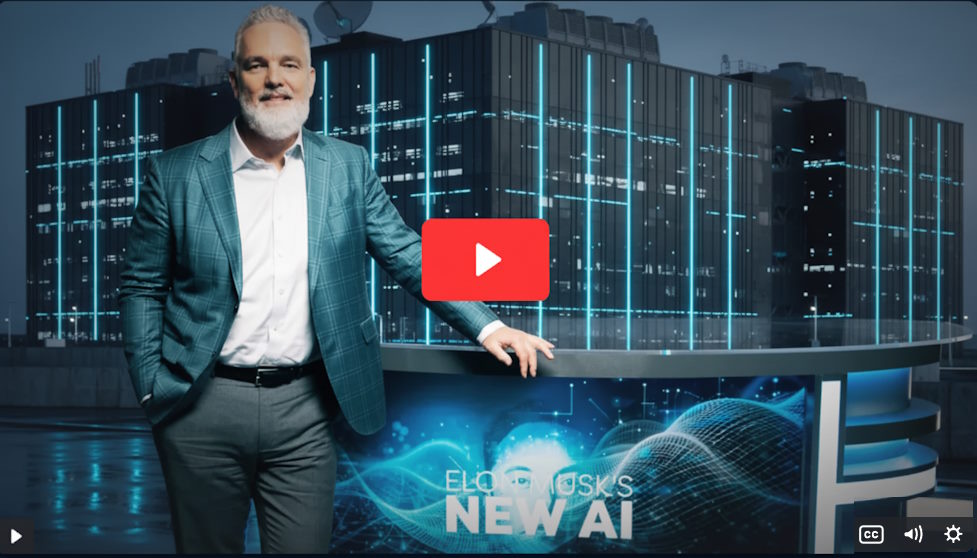Jeff Brown Project Colossus Review 2025 : Is It Worth It?
In the world of artificial intelligence, one name is rapidly gaining attention: xAI — the company founded by Elon Musk. And at the heart of xAI’s strategy lies Project Colossus — a supercomputer facility built at unprecedented scale to train next-gen AI systems.
If you believe AI is just about software and servers, think again: Musk and xAI are betting that compute, scale and hardware infrastructure will decide the next wave of winners.
In this article we’ll cover:
- What Project Colossus is, and why it matters
- How it fits into Musk’s track record of bold technology plays
- The technical details, locations, build-out and scale
- Why investors are talking about it — and what the risks are
- How non-institutional investors might get exposure (and what to watch)
- FAQs to answer common questions
Let’s dive in.
👉 70% OFF: Discover how to invest early in Musk’s Project Colossus.
What Is Project Colossus?
Project Colossus is the codename for the massive AI supercomputer campus being built by xAI in Memphis, Tennessee. According to xAI itself, the facility was built and brought online in record time. (xAI)
Here are the headline facts:
- It was established in a former factory/industrial building (the old Electrolux factory) in South Memphis. (Wikipedia)
- xAI says it deployed the initial build in 122 days, a fraction of the time other data centres typically require. (xAI)
- The facility uses hundreds of thousands of GPUs, including Nvidia H100 and H200-series chips, with plans to expand further. (Medium)
- The mission: train xAI’s large-language model (LLM) family “Grok” (and future versions) at unprecedented scale and speed.
In short: Project Colossus isn’t just another AI lab. It’s being pitched as an industrial-scale intelligence engine, designed to power the next generation of AI models — ones that act, adapt, learn and scale in real time rather than in batches.
Why It Matters
Why all the fuss over hardware and scale? After all, most people focus on algorithms. But here’s the key: in AI, compute + data + architecture = competitive advantage. Musk argues that for truly groundbreaking models, the bottleneck is no longer the algorithm — it’s the speed, the cooling, the infrastructure, the energy, the ability to train faster than your competitors.
Project Colossus aims to tilt that equation. With the scale of Colossus, xAI hopes to train so many parameters, process so much data, and iterate so rapidly that it can leapfrog others. For example: xAI claims the supercomputer will enable Grok to improve daily, drawing fresh data streams, rather than waiting months between retraining cycles. (RD World Online)
From an investment-perspective, the importance is two-fold:
- The infrastructure needed to build Colossus — chips, cooling systems, networking, power generation — means large business opportunities for suppliers, partners and service providers.
- If xAI succeeds in using Colossus to radically advance AI model capabilities (and capture market share), the valuation upside could be enormous.
For those looking for “what’s next” in AI, Project Colossus is one of the loudest signals.
How It Fits Into Musk’s Track Record
Elon Musk has a pattern: he enters a technology space that many believe is saturated or impossible, builds infrastructure or capability that others ignored or dismissed, and then pushes a product that disrupts. Examples include:
- PayPal (online payments)
- Tesla (electric vehicles)
- SpaceX (reusable rockets)
- Neuralink (neurotechnology)
Project Colossus could be the next in that series — only this time in the foundational tech layer of AI itself. By building what the industry calls “AI super-infrastructure,” Musk is placing a massive bet.
For investors, that pattern matters: history shows that when Musk commits to an infrastructure pivot (rather than just a product), related companies can experience outsized returns. Of course, with high risk.
Technical Details: Location, Build-Out, Scale
Location
The facility is located in Memphis, Tennessee, in a repurposed manufacturing building: previously an Electrolux appliance factory. Choosing a pre‐existing large industrial site enabled speed of build. (Wikipedia)
Memphis also offered:
- Access to large electric-power infrastructure
- Cooling/water infrastructure (important for massive computing loads)
- Logistics/transportation advantages
And reportedly favorable incentives from local government.
Build & Speed
xAI claims to have completed the initial build of Colossus in ~122 days. It then expanded soon after to ~200,000 GPUs. (NVIDIA Newsroom)
Other details:
- The GPUs are connected via a high-speed Ethernet network (e.g., Nvidia’s Spectrum-X networking) to coordinate the compute. (NVIDIA Newsroom)
- Cooling architecture, liquid-cooling nodes, and other advanced engineering have been deployed.
👉 70% OFF: Discover how to invest early in Musk’s Project Colossus.
Scale
Here’s how the numbers add up:
- At launch: ~100,000 Nvidia H100 GPUs. (Forbes)
- Expansion plans: double the capacity to ~200,000 GPUs, and then further expansion toward 1 million GPUs. (Wikipedia)
- A recent academic paper forecasting trends in AI supercomputers estimated that the leading system (i.e., Colossus) used ~200,000 AI chips and consumed ~300 MW of power. (arXiv)
To put that in context: many large data centres for AI training operate at tens of MW; Colossus is in the hundreds of MW scale.
Expansion: Colossus 2
xAI has already initiated a second phase, “Colossus 2”, which aims to scale the facility further. Reports indicate that in early 2025 the company acquired a 1 million-sq-ft site in Memphis, with 100-acre land, and is installing massive cooling and power infrastructure.
Industry Context & Competitive Landscape
Supercomputers for AI are evolving rapidly. Academic research shows that compute performance of leading AI systems has been doubling roughly every nine months, with costs and power needs doubling every year. (arXiv)
Within that context:
- OpenAI has built large model-training clusters (e.g., for GPT models)
- Anthropic and DeepMind are also key players
- But xAI claims to be building “the world’s largest AI supercomputer” (Colossus) and intends to leap ahead.
One major competitive advantage could be training speed + scale, meaning faster iteration of model versions, more data, and new applications. That could give xAI an edge if managed well.
Humanoid robotics, real-world agents, autonomous systems — all these are next-layer applications of large models supported by huge compute. Project Colossus aims to support that leap.
👉 70% OFF: Discover how to invest early in Musk’s Project Colossus.
Why Investors Are Talking About It
The “Backdoor” Exposure Question
Since xAI is a private company (i.e., not publicly traded as of the time of writing), many retail investors can’t directly buy “xAI stock”. That has led to investor interest in:
- Identifying companies in the supply-chain (chips, cooling, data-centre infrastructure) that benefit if Colossus succeeds
- Monitoring private funding rounds or pre-IPO positions in xAI
- Timing entry before valuations surge (which will reduce upside)
Signals of Rising Interest
Search-trend data shows increasing queries such as “Project Colossus investment”, “Jeff Brown Project Colossus”, and “Elon Musk Colossus stock.” These suggest retail interest is rising.
Investment-research analysts (such as Jeff Brown) are highlighting this as a potential early wave.
👉 70% OFF: Discover how to invest early in Musk’s Project Colossus.
The Upside Potential
If Colossus enables xAI to build models significantly ahead of the competition, there could be a new breed of winners:
- The model business itself (e.g., commercialising Grok)
- Hardware suppliers (GPUs, servers, liquid-cooling)
- Infrastructure builders (power, data centres)
- Robotics / automation companies relying on advanced models
Each of these represents a potential growth theme.
Timing Matters
Because private valuations escalate rapidly, earlier exposure tends to offer higher upside (but higher risk). Once a company like xAI announces an IPO or large funding round, some of the “easy” upside may already be priced in.
Experts emphasise: getting in before the major public valuation jump is key.
Risks and Realities
Of course, no big opportunity is without big risks. Here are some of the main ones:
Private Company Risk & Liquidity
xAI is a private company. That means:
- No public ticker (yet) for many investors
- Shares may be illiquid (not easily sold)
- Valuations may change dramatically, including dilution from new funding rounds
Execution Risk
- Building and running a supercomputer at this scale is non-trivial. Any delays, cost overruns, or technical issues can derail value.
- The AI model being trained (Grok or its successors) still needs to prove commercial viability against competitors.
Competitive Risk
- OpenAI, Anthropic, DeepMind, and others are all racing. They may leap ahead or capture the market before xAI does.
- If compute alone isn’t enough (data, talent, algorithm also matter), the advantage may erode.
👉 70% OFF: Discover how to invest early in Musk’s Project Colossus.
Regulatory & Environmental Risk
- Such large data-centres consume massive power and water; local regulatory and environmental issues may interfere. For example, Memphis residents have raised concerns about air-quality impacts from gas turbines. (Wikipedia)
- Governments globally are increasingly scrutinising AI for safety, bias and competition issues — which could impact valuations.
Valuation and Timing Risk
- The earlier the investment, the higher the volatility. As the company matures, upside shrinks.
- Mistiming entry or investing without a clear exposure strategy may lead to losses.
Given these risks, investing in this kind of frontier infrastructure requires careful assessment and only allocating what you can afford to lose.
How Can Investors Get Exposure?
Since xAI isn’t publicly traded (as of writing), here are some of the routes investors are exploring:
- Supply chain public companies: Identify companies publicly traded that supply GPUs, data-centre hardware, cooling systems, networking, or power infrastructure that are likely to benefit if Colossus succeeds.
- Private funding rounds: Accredited investors may access xAI or related entities through private placements — though these often carry higher minimums and less liquidity.
- Indirect related themes: Robotics, automation, AI-inference infrastructure, power/energy storage — sectors that may benefit from advanced AI infrastructure build-out.
- Pre-IPO positioning / watch alerts: Some research services track companies like xAI pre-IPO, offering alerts when they expect an offering or secondary sale.
- 👉 70% OFF: Discover how to invest early in Musk’s Project Colossus.
If you consider exposure, some questions to ask:
- What is the path to commercial revenue for xAI?
- Which public companies in the supply chain have clear ties to the project?
- What is the valuation trend (is the window closing)?
- What risk controls do you have (e.g., stop loss, size of allocation)?
Why Project Colossus Could Disrupt Entire Industries
Here are some of the major applications that Colossus-style infrastructure could impact:
Search, Advertising & Information
Large language models trained at scale may shift the way we search and consume information. If a model can answer questions, provide insights, and do so faster than traditional search engines, that threatens the $600 billion+ digital advertising market dominated by legacy players.
Healthcare
Advanced AI models can process massive genomic, medical-image and clinical-trial datasets. With sufficient compute, breakthroughs in drug discovery, diagnostic automation, personalized medicine become feasible. Colossus-scale may accelerate that.
👉 70% OFF: Discover how to invest early in Musk’s Project Colossus.
Energy & Climate
Massive compute can be applied for grid optimisation, renewable-energy forecasting, battery modelling and similar high-complexity problems. With power infrastructure already built to support supercomputer loads, the energy-AI intersection becomes real.
Robotics & Automation
From humanoid robots (e.g., xAI has flagged interest there) to warehouse automation, advanced models running on massive compute back-ends could power autonomous systems in factories, logistics, agriculture. This crosses the “manifested AI” frontier: AI embedded in machines interacting physically with the world.
Infrastructure & Chips
Of course, the infrastructure itself is a transformative industry: GPUs, networking hardware, data-centre construction, power/energy systems. Colossus is not only a sign of what’s coming, but an instantiation of it.
The Investment-Timing Window
As with all frontier plays, timing is important. The scenario looks something like:
- Stage 1: Project announced / initial build-out — early low competition, high upside, high risk.
- Stage 2: Build-out grows, press attention increases, valuations rise — upside compressed, risk still high.
- Stage 3: Commercial deployment, more public access, likely IPO or public funding — upside lower, risk somewhat lower.
For Project Colossus, many believe we are between Stage 1 and Stage 2: the infrastructure is visible, scaling rapidly, but commercialisation and public investment access are still evolving. That means there is still a window, but the clock may be ticking.
Investors often ask: “What’s the trigger?” Possible triggers include:
- A public listing of xAI or one of its major suppliers
- A commercial release of a model (e.g., Grok full-version) that disrupts a major market
- A major strategic partnership or licensing deal
- Regulatory / infrastructure approval milestones (power, data-centre, international build-outs)
Once such triggers occur, the “early – high-upswing” phase may end and valuations may become premium.
👉 70% OFF: Discover how to invest early in Musk’s Project Colossus.
Case Study: Grok the Chatbot + Colossus
A core part of the story is the AI model family called Grok developed by xAI.
- Grok is the flagship model for xAI, launched in late 2023/2024 and positioned as a competitor to other large-language models like ChatGPT. (Wikipedia)
- The training of Grok is being accelerated by Colossus: at scale, faster iteration, continuous retraining (rather than quarterly).
- If Grok achieves superior performance or faster updates, that performance gap could be a competitive moat.
Thus, Project Colossus is not just an infrastructure play, but a model-platform play: faster, better AI models → market disruption → value realisation.
👉 70% OFF: Discover how to invest early in Musk’s Project Colossus.
Strategic Implications for Investors
Here are some strategic take-aways for investors considering this theme:
- Focus on infrastructure winners: If you believe in the theme, look for companies supplying the pieces (chips, data-centre hardware, power/energy storage) rather than only the headline company.
- Size your exposure: In high-risk high-reward plays, allocate only what you can afford to lose or hold long term.
- Track key milestones: Watch for funding rounds, IPO talk, commercial release of model, partnership announcements, regulatory approvals — these often mark valuation inflection points.
- Consider supply-chain/liquid plays: Since the core company is private, publicly-traded suppliers may offer more accessible avenues.
- Manage liquidity: Private investments often lock up capital; public exposures offer more flexibility.
- Risk vs reward timeline: Earlier exposure = more upside but more risk; later exposure = less upside but potentially less risk.
Final Thoughts
Project Colossus is one of the boldest infrastructure plays in AI today. It isn’t merely about AI models; it’s about building the infrastructure that enables the next leap in AI – one where the machines learn faster, iterate more, embed in the physical world (robots, real-time agents) and scale across industries.
For investors, that means potential for large gains — but also high complexity and risk. Since xAI is private, indirect exposure via supply-chain companies or pre-IPO vehicles is currently the realistic route. Timing matters.
👉 70% OFF: Discover how to invest early in Musk’s Project Colossus.
If you believe in the underlying theme — that hardware + compute scale + data architecture will drive the next AI wave — Project Colossus offers a lens into that world. The key is to act with clarity: know what you are buying into, understand the risks, and monitor major milestones.
Frequently Asked Questions (FAQs)
Q1: What exactly is Project Colossus?
A1: Project Colossus is the supercomputer project by xAI (founded by Elon Musk) located in Memphis, Tennessee. It is designed to train the Grok language models and future AI systems at massive scale. (xAI)
Q2: Can I buy stock in Project Colossus or xAI?
A2: As of now, xAI is a private company, and there is no publicly-traded “Project Colossus stock”. Some investors explore indirect exposure via public companies in the supply-chain or wait for a pre-IPO/IPO event.
Q3: What companies could benefit if Project Colossus succeeds?
A3: Potential beneficiaries include GPU manufacturers (e.g., Nvidia), server/data-centre equipment providers (e.g., Supermicro), networking hardware firms (e.g., firms using Nvidia Spectrum-X), power/energy-storage companies, and construction/infrastructure firms tied to large-scale data-centres.
👉 70% OFF: Discover how to invest early in Musk’s Project Colossus.
Q4: What are the major risks?
A4: Key risks include: execution delays, competition from other AI firms, regulatory/environmental push-back, private-company illiquidity, valuation surges reducing upside, and technology changes invalidating the advantage.
Q5: Why did they choose Memphis, Tennessee, for Colossus?
A5: Several reasons: the site offered a large existing industrial building (former Electrolux factory), access to power/water infrastructure, logistical advantages, and a speed of build that enabled rapid deployment. (Wikipedia)
Q6: What is “Grok” and how is it related to Colossus?
A6: Grok is the large-language model developed by xAI (a competitor to ChatGPT, etc.). Colossus is the compute infrastructure being used to train Grok (and its future versions) at scale, enabling faster iteration, continuous learning and potentially superior performance.
Q7: How far has Colossus scaled so far?
A7: Public sources indicate an initial ~100,000 GPU deployment (H100s), with expansion to ~200,000 GPUs and plans toward 1 million GPU scale.
Q8: Can small retail investors realistically get involved?
A8: Indirectly yes — via supply-chain companies, tracking partner firms, or pre-IPO vehicles (if accessible). But direct investment in xAI currently is limited and carries higher risk and higher minimums.
👉 70% OFF: Discover how to invest early in Musk’s Project Colossus.
Q9: What milestone should I watch to know when the opportunity might close?
A9: Milestones include: a major funding round or IPO announcement, a commercial release of Grok with market impact, or supply-chain companies showing major revenue lift tied to Colossus. After such events, much of the early-stage upside may diminish.
Q10: Is this purely about “AI software”?
A10: No — that’s the key point. This is as much an infrastructure play as a software one. Training large models at scale requires massive hardware, cooling, power, networking. Project Colossus is about building that foundation.
👉 70% OFF: Discover how to invest early in Musk’s Project Colossus.



